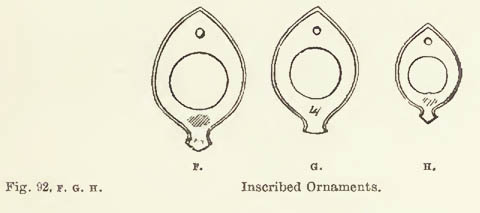Previous First Next
SALAMIS IN THE ISLAND OF CYPRUS.
BY ALEXANDER PALMA DI CESNOLÀ, F.S.A.,
page 52
and a few on the three largest of the rings appear to belong to the Phœnician language. But from the imperfect number of the relics, and the indistinctness of some of the characters, no satisfactory interpretation has yet been arrived at (figs. 92, A—h). It has been conjectured that these eight rings of shell formed part of a necklace or breast ornament, to be worn by a priest, or other public functionary, upon his breast, the smaller pieces overlapping the larger ones, like tiles,

in a vertical row; in which case the inscriptions perhaps run on in grammatical sequence from the less to the greater circles or margins of the relics.
CHAPTER IX.
STONE ANTIQUITIES
INSCRIBED STONES — PHOENICIAN NUMERALS — CYPRIOTE INSCRIPTIONS — STATUETTES ----- GREEK INSCRIPTIONS ------ ALTARS ----- TRIPOD ------ VASES---- AMULETS—STAMPS—TYMPANUM OF EARLY CHRISTIAN WORK.
 HE stone antiquities which rewarded my labours in excavating several prolific sites in the island of Cyprus are not particularly numerous, but in themselves, from the frequency with which they are associated with inscriptions, they possess an enhanced interest. It is a curious fact, that the calcareous stone which is found in the island in great abundance contributes almost always the material for these objects; and from the peculiar nature of its composition, it does not easily discolour from age or exposure: hence, to a casual observer, the stone objects, which undoubtedly range over a period of more than a thousand years, and embrace representations of Egyptian, Phœnician, Assyrian, Greek, Roman, and Early Christian art, appear to have been made within a comparatively recent time—so fresh and clear is the colour of the stone of which they are formed. Next to the objects in calcareous stone, those in marble are most numerous. I have been able to procure several slabs of this material, with Greek inscriptions, and of a fairly early period. The accompanying woodcut (fig. 93) represents a fragment of hard stone, two and three-quarter inches in length, which I found at Cerina, or Cyrene, on the North coast of the Island of Cyprus. M. Piérides considers that the inscription which is scratched upon it is probably part of some Phœnician numeration or calculation. The first sign to the right he believes to represent 20, and the other strokes, on the first line, 1 each. The numeral 20 is repeated on the second line. HE stone antiquities which rewarded my labours in excavating several prolific sites in the island of Cyprus are not particularly numerous, but in themselves, from the frequency with which they are associated with inscriptions, they possess an enhanced interest. It is a curious fact, that the calcareous stone which is found in the island in great abundance contributes almost always the material for these objects; and from the peculiar nature of its composition, it does not easily discolour from age or exposure: hence, to a casual observer, the stone objects, which undoubtedly range over a period of more than a thousand years, and embrace representations of Egyptian, Phœnician, Assyrian, Greek, Roman, and Early Christian art, appear to have been made within a comparatively recent time—so fresh and clear is the colour of the stone of which they are formed. Next to the objects in calcareous stone, those in marble are most numerous. I have been able to procure several slabs of this material, with Greek inscriptions, and of a fairly early period. The accompanying woodcut (fig. 93) represents a fragment of hard stone, two and three-quarter inches in length, which I found at Cerina, or Cyrene, on the North coast of the Island of Cyprus. M. Piérides considers that the inscription which is scratched upon it is probably part of some Phœnician numeration or calculation. The first sign to the right he believes to represent 20, and the other strokes, on the first line, 1 each. The numeral 20 is repeated on the second line.
 At Cerina, a site worthy of exploration, I also found a calcareous stone of rectangular shape, measuring four inches and three-quarters in length, and two inches and a-half in height, with the left hand upper corner roughly rounded off. It is represented by the accompanying illustration (fig. 94), and contains three lines of Cypriote inscriptions, the final mi of the first line being At Cerina, a site worthy of exploration, I also found a calcareous stone of rectangular shape, measuring four inches and three-quarters in length, and two inches and a-half in height, with the left hand upper corner roughly rounded off. It is represented by the accompanying illustration (fig. 94), and contains three lines of Cypriote inscriptions, the final mi of the first line being
Previous First Next
|